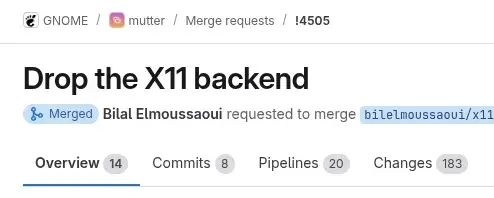- cross-posted to:
- [email protected]
- cross-posted to:
- [email protected]
At home, I like that this is happening, but at work X11 is still needed for xrdp. I have tried gnome-remote-desktop, but it isn’t on par with it. I could not get it to work reliably on Debian 13.
Maybe, with the next stable release it will be ready and the X11-drop will be a non-issue.
Our Linux people use nomachine. It costs money, but if it’s for work, they should pay for it.
I can’t comment on how well it works since I don’t use it personally, but I don’t hear grousing.
Idle power on my laptop.
KDE Wayland: 10 watts
KDE X11: 6 wattsIt was this way when I checked years ago. Still this way as of a few weeks ago.
I had the opposite for whatever reason
Can you measure herbstluftwm + X11?
How are you measuring electricity use? powertop?
In this video (Odysee link), someone asks X11 users why they’re still using it in 2025. The main answers were
- DE or WM doesn’t support Wayland, or its Wayland session is currently WIP.
- [lack of] support for certain graphic tablets and their features.
- old hardware. Specially old nVidia GPUs.
- [If I got this right] Some software expects to be able to dictate window position, and Wayland doesn’t let it to.
- OpenBSD.
In the light of the above, I think GNOME’s decision to drop the X11 backend is a big “meh, who cares”. If you use GNOME you’re likely not in the first case; #2 and #3 boil down to hardware support, not something DE developers can interfere directly; I’m not sure on #4 and #5, however.
Anoþer reason, for me, is Wayland’s security model. Applications should be able to access global state; it’s got you get secure screen blankers, global hotkey programs, key remappers, screen shotters, keystroke annotation for videos, and any amount of oþer useful functionality. Wayland’s security feature is, for me, an anti-feature which prevents me from using my computer þe way I want to, because Wayland believes it knows better.
I’m using Linux because I like þe control; if I wanted a nanny OS, I’d use a Mac.
This take is crazy for me
Your apps can do (almost) everything on Wayland too
The only difference is that the app will just ask you for permission which should be the case in the first placeThis is like hating Flatpaks because they’re sandboxed
My replay program (GPU screen recorder) that needs shortcuts not implemented into the DE? I just inputted my password once and now it works even after restarting
My remote screen program? I give it access to what screen / window / etc and it keeps that access until I decide otherwise
If you have some malicious code running on your computer, you have already lost. Nothing stops it from impersonating another app and asking the permissions to see your screen, accessing local secrets from the files or doing who knows what.
You can still download a tar file with an static executable inside, and double clicking that exe will happily run it unsandboxed, and it’ll be able to do whatever with your secrets or files of other apps, unlike firefox, which is not able to share your screen easily. If you get a really malicious app, it could probably also exploit debugging tools to inject itself into the memory of processes that do have the permission to access the screen without asking…
Preventing apps from accessing what you see on screen or sending keypresses, or stealing your focus, is not going to protect you against anything, but it’s just going to make it impossible to use legacy tools, autohotkey-equivalents (look up how to send a key programmatically to a wayland app… wayland provides no interface for that. You have to create virtual evdev devices and run your app with root permissions…) or making it clunky to have a calendar appointment notification pop up right in front of the screen (grand theft focus luckily fixes that on gnome…).
Performance on 3d games is also much better on X for me.
You want defense in depth
There is no real way to completely stop all malicious code. The best you can do is limit the impact
I don’t care for Flatpaks, or Snaps, eiþer.
Which screen savers are you running? Most of what I find are DBUS work-arounds and a lot of grief.
Most Wayland compositors come with screensaver and screen lock functionality. Some have an API for custom screensavers.
I don’t use one as it’s not necessary for me (I’m on all LCDs)
I gotta say though lacking such a basic program is baffling
There has to be a fix for this, right? Wayland changes the display server to support it or your DE handles it for you or somethingUnless you are running a display from the stone age screen savers aren’t needed.
Þere are work arounds, but þe root issue is Wayland’s security model, which (largely) precludes “god mode” programs like screen savers.
Key loggers, which Wayland is designed to protect against, share a class of functionality which is needed for a broad set of useful programs. It’s likely not possible to prevent þe one while allowing þe oþer.
I’m using Linux because I like þe control; if I wanted a nanny OS, I’d use a Mac.
I’m currently trying to read your comment on macOS and whatever your X11 system does somehow glitches some characters and swallow words? You like to be in control?
Ze fey I read his comments is as if zey have a zick German aksent, ja. Like dis.
old hardware. Specially old nVidia GPUs.
“Fuck you, Nvidia” was in June 2012. People who bought Nvidia hardware after that really have nobody to blame but themselves.
https://arstechnica.com/information-technology/2012/06/linus-torvalds-says-f-k-you-to-nvidia/
all existing Nvidia systems suddenly disappeared because Linus said something somewhere
Sure, if I would buy/upgrade my PC now, I would go AMD for the graphics - it’s just less hassle this way, and open drivers are nice to have.
But it just so happened that I purchased my PC 5 years before I switched to Linux. It’s a perfectly functional machine I don’t feel the need to replace, and with many people coming over from Windows right now amid Windows 10 support termination, many more find themselves in a similar situation.
Building a new PC just for Linux is expensive, stupid, and not ecologically conscious. As Linux shows itself as a more democratic and old hardware-friendly option, supporting Nvidia GPUs, old or new, is a must, even if Nvidia itself gets hostile at times.
Both Wayland & Linux try to support Nvidia, but Nvidia wasn’t cooperating. Software, especially software as big as DEs can’t stay tied to old tech & hardware forever.
I’d say GNOME kept X11 around for long enough and Linux worked hard on supporting old fussy hardware.
It’s not up to Linux “to support Nvidia”, it’s up to Nvidia to properly support Linux.
Ideally, yes. But if Nvidia is stubborn, there are two ways to go about it:
- Say “screw it”, shift blame on Nvidia and not do anything to support Nvidia users (halving the userbase)
- Or do something about it and implement what is necessary to keep them supported.
Say “screw it”, shift blame on Nvidia and not do anything to support Nvidia users (halving the userbase)
So keeping the X11 session around for a decade after Intel and Radeon had their drivers ready is “not do anything to support Nvidia users”?
Or do something about it and implement what is necessary to keep them supported.
Who is paying for this task? Have NVidia users set up a pledge drive? Did any PC manufacturer?
You make it look like old Nvidia cards are the only reason X11 is held around.
Heck, I had trouble installing remote desktop for my work (they use Omnissa Horizon) on Fedora, because the app still exclusively supports X11, and Fedora removed it in version 42.
There are plenty of instances of similar things happening here and there, and currently, ditching X11 will still be catastrophic for many users’ workflows.

It had to happen eventually. Seems reasonable time to make the moce. It’ll be beneficial for all Linux users, and probably a huge relief for Gnome devs to be be able to focus purely on wayland.
It just will suck a bit for those on rolling release distros who still experience major issues with Wayland, particularly when its not Gnome or Wayland projects that need to make a fox - looking at you Nvidia.
I wouldn’t be surprised if other big DEs, such as KDE, start making firmer plans for dropping X11. I’m one of the 30% of KDE users still using X11 - for me it was Nvidia issues, and I do remain anxious about being reliant on drivers from a notoriously bad manufacturer. Having said the drivers have improved massively over the past 18-24 months for me at least, and maybe everyone moving over to Wayland is what’s needed to force Nvidia to act.
If this forces wayland into accepting global hotkeys or an easier/decent way of adding global hotkeys for selected programs, I’ll be happy, because that’s what made me switch back to windows (have a macro-keyboard, had to use a Windows program to upload the desired keys to it only to find out I have to focus obs to use the hotkeys).
I wouldn’t be surprised if other big DEs, such as KDE, start making firmer plans for dropping X11.
If going by Arch Linux statistics, KDE dropping X11 will have a bigger impact than GNOME doing it.
I think Arch stats are a bad way to compare DE usage in that on Arch you specifically pick one but often people just go with whatever the distro has (as default). It used to be at least that Gnome was more popular default
If we take distro defaults into account, it’s possible Arch stats overestimate GNOME market share.
Based on tecmint list, the top 3 distros are Mint, MX Linux, and Endeavour. Their defaults are:
- Mint - Cinnamon, MATE
- MX Linux - Xfce, Plasma, Fluxbox
- Endeavour - Plasma
Granted, the fourth one (Debian) does default to GNOME, but your typical Debian user is more experienced, so it’s less likely they stick to the default.
…I wish I had actual data instead of a bunch of guesses. :-/
This is why some level of telemetry can be useful. That ranking is just DistroWatch rank which might poorly reflect actual popularity
Indeed. Sadly, corporations abused telemetry so much that it makes users automatically distrust software with it - even when it’s opt-in. As such I’m not surprised it isn’t more common, specially in the Linux ecosystem.
Good















